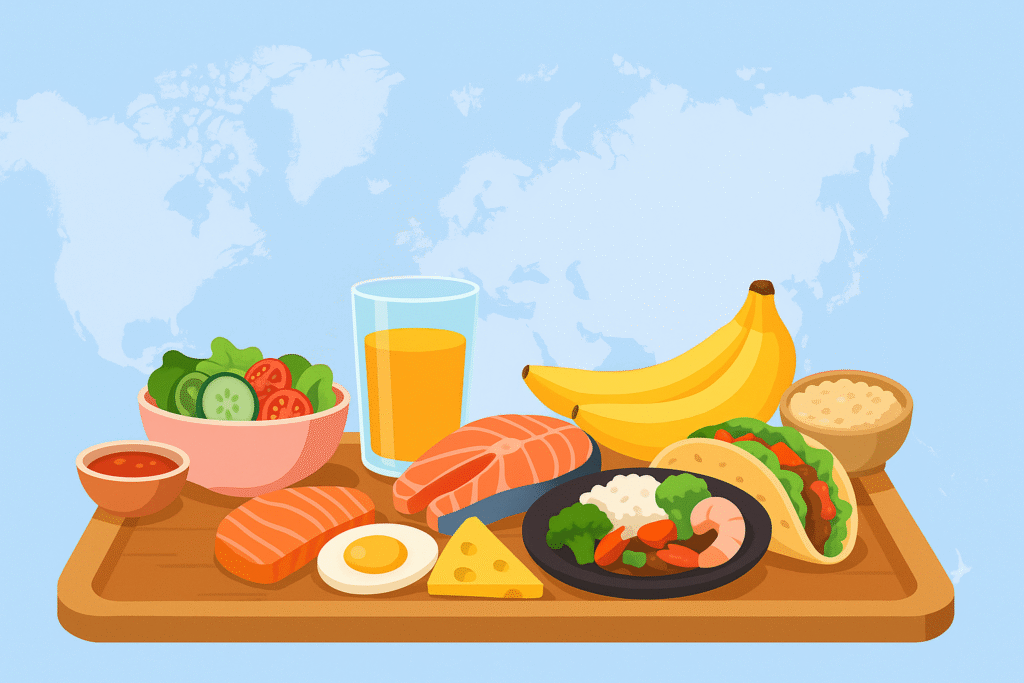Nutrition is the cornerstone of health, and different cultures have developed unique approaches to eating that promote well-being. From the Mediterranean diet to the Japanese emphasis on balance, each country has something valuable to teach us about healthy eating. In this post, we’ll explore the best nutrition plans from around the world and what makes them effective. Packed with trending keywords like “nutrition plans,” “healthy eating,” and “diet trends,” this content is SEO-optimized to rank high on Google.
Introduction: The Global Plate
With searches for “nutrition plans,” “healthy eating,” and “diet trends” surging on Google Trends, it’s clear people are eager to optimize their diets. But with so many options, choosing the right approach can feel daunting. That’s where the world’s healthiest cultures come in. These countries have perfected their dietary habits over generations, often linking them to lower chronic disease rates and longer lives. Let’s dive into what they get right.
1. The Mediterranean Diet: A Heart-Healthy Approach
The Mediterranean diet consistently tops lists of the world’s best nutrition plans. Trending terms like “Mediterranean diet benefits” and “heart-healthy foods” reflect its popularity. Here’s what it includes:
- Olive oil: A source of monounsaturated fats that support heart health.
- Fresh fruits and vegetables: Loaded with antioxidants and fiber.
- Whole grains: For sustained energy and better digestion.
- Lean proteins: Like fish and poultry, low in saturated fats.
Its strength? A focus on healthy fats and plant-based foods, proven to lower heart disease and stroke risks.
2. Japan’s Okinawa Diet: Longevity Through Balance
The Okinawa diet, from Japan’s longevity hotspot, is gaining attention with keywords like “Okinawa diet” and “Japanese longevity.” It features:
- Seaweed: Packed with minerals and antioxidants.
- Soy products: Tofu and miso offer plant-based protein.
- Sweet potatoes: A vitamin- and fiber-rich staple.
- Small portions: Promoting mindful eating.
The secret here is balance and moderation, key to Okinawa’s impressive life expectancy.
3. India’s Ayurvedic Diet: Personalized Nutrition
Ayurveda, India’s ancient wellness system, is trending with searches for “Ayurvedic diet” and “personalized nutrition.” It emphasizes:
- Spices: Turmeric and ginger for their anti-inflammatory benefits.
- Whole foods: Grains, legumes, and veggies form the base.
- Dosha-based eating: Customizing meals to your body type.
Its standout feature is personalization, tailoring nutrition to individual needs.
You can check our blog on Indian Food based on body types
4. Sweden’s Nordic Diet: Sustainability and Health
The Nordic diet is rising in popularity, with keywords like “Nordic diet” and “sustainable eating” on the upswing. It includes:
- Root vegetables: Beets and carrots, full of nutrients.
- Berries: Antioxidant-rich and vitamin-packed.
- Whole grains: Rye and barley for fiber.
- Fish: Omega-3s for heart health.
It excels in combining sustainability with health, using seasonal, local ingredients.
5. Mexico’s Traditional Diet: Colorful and Nutrient-Rich
Before processed foods took over, Mexico’s traditional diet was a nutritional powerhouse. Searches for “traditional Mexican diet” and “nutrient-rich foods” are trending. It features:
- Beans: Protein and fiber in every bite.
- Corn: Complex carbs via tortillas.
- Avocados: Healthy fats and vitamins galore.
- Chili peppers: Capsaicin to boost metabolism.
Its nutrient density shines through in its vibrant, flavorful ingredients.
6. Australia’s Bush Tucker Diet: Native Superfoods
Australia’s indigenous diet, known as “Bush Tucker,” is gaining traction with searches for “Australian superfoods” and “native diets.” It includes:
- Kangaroo meat: Lean protein with less fat than beef.
- Quandong: A native fruit rich in vitamin C.
- Wattleseed: A protein-packed seed with a nutty flavor.
- Bush tomatoes: High in antioxidants.
Its strength lies in native superfoods that are nutrient-dense and sustainable.
7. The UK’s Flexitarian Diet: Plant-Forward with Flexibility
The UK’s flexitarian approach is trending with keywords like “flexitarian diet” and “plant-based eating.” It focuses on:
- Plant-based meals: Reducing meat without eliminating it.
- Seasonal produce: Fresh, local fruits and vegetables.
- Whole grains: Oats and barley for fiber.
- Occasional meat: High-quality, sustainably sourced.
Its appeal is in its flexibility, making healthy eating accessible and sustainable.
8. The USA’s DASH Diet: Combating Hypertension
The DASH (Dietary Approaches to Stop Hypertension) diet is a U.S. favorite, with searches for “DASH diet” and “heart health” on the rise. It emphasizes:
- Low sodium: Reducing salt to lower blood pressure.
- Fruits and vegetables: Rich in potassium and magnesium.
- Lean proteins: Fish, poultry, and beans.
- Whole grains: For fiber and nutrients.
Its focus on heart health and blood pressure management makes it a go-to for many Americans.
Conclusion: A World of Nutritional Wisdom
Whether it’s the Mediterranean’s healthy fats, Okinawa’s balance, Ayurveda’s personalization, the Nordic focus on sustainability, Mexico’s nutrient-rich variety, Australia’s native superfoods, the UK’s flexible approach, or the USA’s heart-healthy DASH diet, these nutrition plans offer a global buffet of wisdom. By blending these elements into your own diet, you can tap into centuries of healthy eating know-how.
With “nutrition plans” and “healthy eating” dominating search trends, this is the perfect time to explore what works worldwide. Which of these approaches inspires you to rethink your plate?
